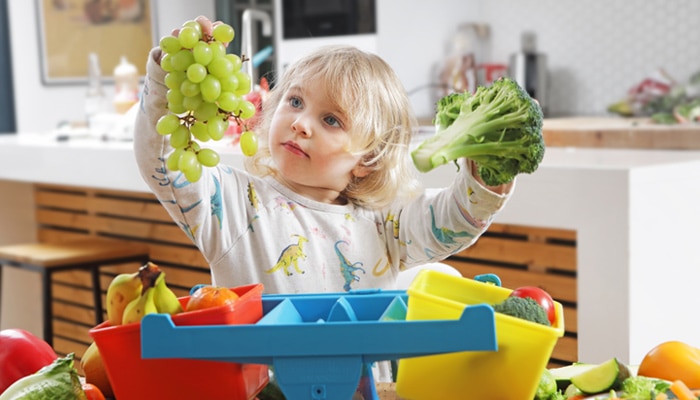While we believe that the books and resources recommended may be of value to you, keep in mind that these are suggestions only and you must do your own due diligence to determine whether the materials are appropriate and suitable for your use. PNC has no sponsorship or endorsement agreement with the authors or publishers of the materials listed.
FARM TO PRESCHOOL

Fruit or Vegetable?
Children will explore the differences between fruits and vegetables.

Lesson Objective
Children will explore fruits and vegetables, sort and classify them, and compare seeds.
Science
What You'll Need
- An assortment of vegetables such as lettuce, cucumbers, tomatoes, peppers, celery, broccoli
- An assortment of fruits such as pineapple, bananas, grapes, strawberries, peaches, kiwi, apples, pears
- Sharp knife – adult use only
- Cutting board
- Paper plates – 1 per vegetable/fruit
What To Do
Note: Before beginning this activity, have the children wash their hands.
- Display the assortment of fruits and vegetables, and ask the children to identify them.
- Have the children state their observations as they compare the fruits and vegetables (see Guiding Student Inquiry).
- Tell the children that some of the foods are fruits and some are vegetables, and that all of them grow from plants.
- Tell the children that the difference between fruits and vegetables is that fruits are the ripened part of a flowering plant that contains the seeds (see Did You Know?). Vegetables grow from plants, but they do not have seeds on or inside them.
- Tell the children that they will be sorting the foods and placing the fruits on one side of the table and vegetables on the other.
- Tell the children that you will cut the foods in half to find out which ones contain seeds.
- One at a time, cut each of the vegetables/fruit (except strawberries, whose seeds are on the outside of the fruit) in half, and look for the seeds.
- Enlist the children’s help with sorting the foods – fruits on one side of the table, vegetables on the other.
- In order to avoid any confusion with some vegetables that are actually fruits, such as cucumbers, tomatoes, and peppers, add a middle section to the sorting. Explain to the children that some fruits are used as vegetables when we cook, but they are actually fruits.
Resources
Home School Resources
Home educators: use these printable lesson PDFs to teach this lesson to your home schoolers. They're available in English and Spanish.
Content Provided By
Common Core State Standards Initiative – These lessons are aligned with the Common Core State Standards ("CCSS"). The CCSS provide a consistent, clear understanding of the concepts and skills children are expected to learn and guide teachers to provide their students with opportunities to gain these important skills and foundational knowledge [1]. Visit the CCSS



